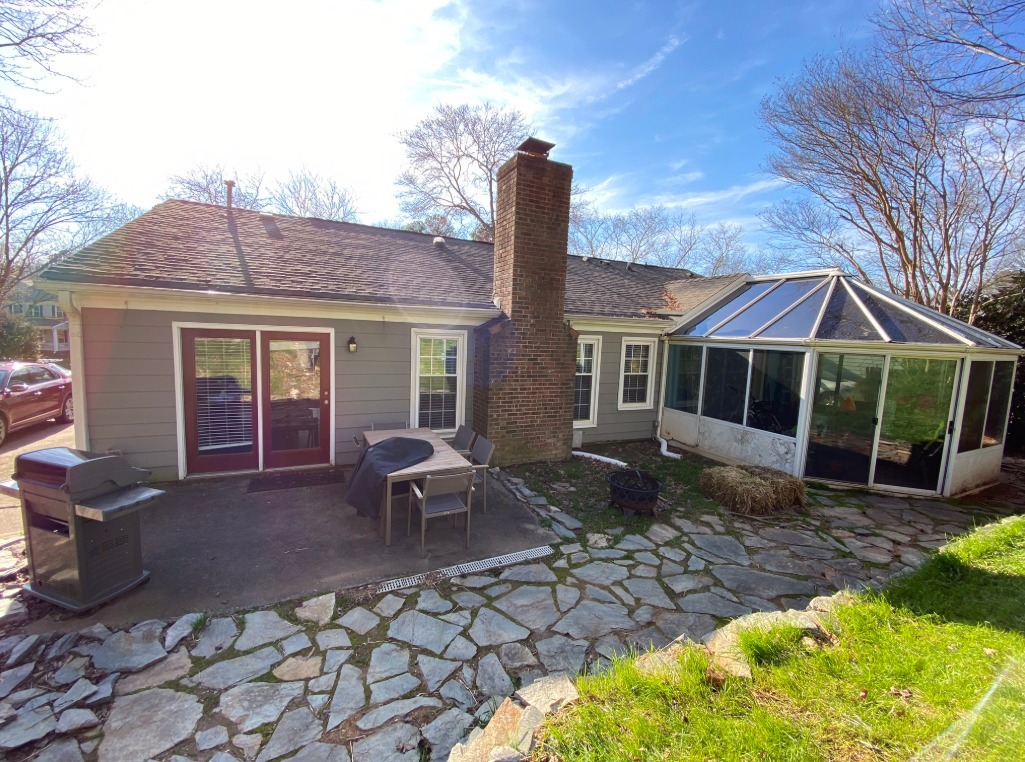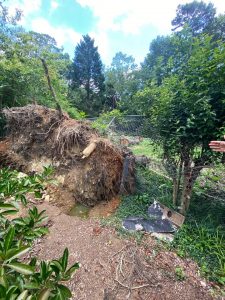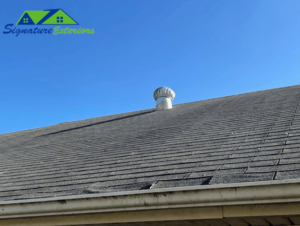It’s common to see roof damage caused by trees after a large storm or tornados in some parts of the country. Unfortunately, it isn’t always possible to prevent roof damage by trees in severe weather. However, there are easy steps that homeowners can take to prevent roof damage caused by fallen branches, pine needles, and leaves. There are significant benefits to having trees around your home, but homeowners must understand the maintenance required to extend the life of your roof. Signature Exteriors has put together this guide to provide homeowners with five tips to prevent tree damage to your roof while still enjoying the benefits of having them around your home.
Benefits of Trees Around Your Home
- Blocking Wind: One significant benefit of having large, mature trees around your home is that they help protect your roof from high winds. High winds can cause damage to your roof shingles which is a common cause of roof leaks.
- Ultraviolet (UVA) Protection: Large, mature trees also provide shade for your roof, which will help reduce the UV light hitting your home. UV light is known to shorten the lifespan of most roofing materials.
- Reduce Air Conditioning Costs: Shingles on a roof absorb heat from the sun throughout the day and radiate that heat back into your home. The shade that tree’s around your home provide can help lower the temperature in your home. Did you know the United States Department of Agriculture reports that the net cooling effect of a young, healthy tree is equivalent to ten room-size air conditioners operating 20 hours per day?
Disadvantages of Trees Around Your Home
- Roof Damage Caused by Falling Trees: Even if the trees around your home seem sturdy and grounded, there is always a chance that a tree could fall on your roof should it be damaged, ill, or too weak to withstand a high wind storm. Keep an eye out for splitting tree trunks, fungus, rotting branches, leaning, swollen spots, discolored leaves, peeling bark, or missing leaves (when the tree is in season), as these can all be signs that the tree is weakening and can lead to a tree falling on your home should this not be addressed. If you are unsure of what to look for, consider bringing in a local tree expert (arborist) to evaluate the trees around your home.
- Falling Tree Branches: It might not seem like a small tree branch could do much harm, but they’re the cause of most roof damage! If you notice tree branches that have fallen near your roof, go ahead and remove them. Even small branches can scratch your roof shingle and cause the protective outer layer on the shingles to be compromised. Pay close attention to this in the winter months when the weight of snow and ice causes tree branches to fall.
- Low-Hanging Branches: Start by pruning the trees surrounding your home. Same as above, these low-hanging branches can cause the protective outer layer on your shingles to be compromised, and that will leave your roof vulnerable to roof leaks.
- Falling Leaves and Pine Needles: You do not want to have debris of any kind littering your roof because it causes wear and tear that can lead to your roof failing prematurely. Fallen debris from trees, such as leaves and pine needles, hold moisture on your roof, which makes it a breeding ground for mold, moss, and algae growth, all of which could leave you with costly roof repairs. Leaves and pine needles can also clog your gutters.
- Dropping Nuts, Fruits, and Other Debris: While most trees only drop leaves, which will not damage your roof upon impact, some have much heavier ammunition that can cause damage. Homeowners want to avoid planting trees that produce fruits and nuts near their homes to prevent damage.
- Excessive Shade: A little shade can benefit during the summer months, but too much shade can make it difficult for water to evaporate off of your roof rapidly. This standing moisture can allow water to soak into your roof and ultimately can cause roof leaks.
- Animal Access: Trees can allow access for animals to gain access to your roofs, such as squirrels, possums, and raccoons. While these animals may sit on your roof for a while, others may choose to damage the exterior and gain access to your attic. It is wise to keep tree branches trimmed so that these animals cannot access your roof via trees.
Now that we have discussed the advantages and disadvantages of having trees near your home, you might be asking yourself, “what can I do to prevent trees from damaging my roof?” Our team of roofing experts has compiled their best advice for preventing this damage and increasing the lifespan of your roof.
Tips to Prevent Roof Damage Caused by Trees
- Trim the Trees: Trim all branches that are too close to your roof. If you are not comfortable doing so, call a tree expert, an arborist, to take care of it for you. A professional may be ideal as they will take all necessary precautions to protect your roof while performing the tree trimming. If you have to trim 25% or more from the tree, it is worth looking into having it removed. A tree that experiences this amount of trimming is likely to die and fall, possibly onto your roof.
- Placement of Trees: If you are looking to plant trees or remove the ones you think may cause a danger to your home, we recommend that trees be at least 15 to 20 feet from your home. Smaller trees should be at least 15 feet from your home, while more sizable trees should be 20 feet or more from your home.
- Prune Young Trees: It is a good idea to prune the young trees around your home to help control tree growth. By performing regular pruning on these young trees, you can create strong crotches (junction between the tree branch and trunk) that will make them less likely to break off in storms.
- Clean Your Roof and Gutters: Remove debris as soon as you see it accumulating on your roof or in your gutters. If you have trees that drop debris all year long, we recommend that you perform roof and gutter maintenance every few months. Gutter guards are also a great option to help keep your gutters clear and working correctly. Ask us about recommended gutter guards that work best in your local region. We recommend products such as LeaFree Gutter Guard or Gutter Rx Gutter Guard in the Charlotte area.
- Cut Down Unstable Trees: If you aren’t sure if a tree is stable, bring in an arborist to provide you with their recommendations. If you plan to remove the trees yourself, use caution and recommended safety precautions. Always check your local city bylaws as you may be prohibited from cutting down some species. Other bylaws prohibit removing trees with specific trunk diameters.
A Tree has Fallen on my Roof, What Now?
We mentioned earlier that roof damage caused by trees is not always preventable. Unfortunately, with high winds, heavy rains, or snowfall, even well-maintained trees can fall on your home and damage your roof. When this happens, we recommend you follow these steps:
- Evacuate: If a tree has fallen on your roof or punctured your roof, the structure may be compromised. Few trees are capable of collapsing a well-maintained home, but there can still be falling debris that causes a hazard to you and your family. Until you have had an expert assess the damage, it is better to be safe than sorry. Call your local tree removal experts. We have partnered over the years with Heartwood Tree Service. Click here to get in touch with Heartwood Tree Service.
- Call Your Insurance Provider: Your insurance provider may want to send someone to inspect the damage and help walk you through filing a claim. Make sure you know what your deductible is and be prepared to pay it. Photograph all damage that you see and any item that has been damaged, as the insurance inspector may miss something vital to repair or replace your roof. We strongly recommend having a roofing expert present for the insurance inspection. Click here to schedule an appointment.
- Assess the Roof Damage: While you wait on professional help, survey the area yourself. Please take photos of your home’s interior and exterior damage and provide them to your insurance company. Use caution. A fallen tree can pull down an electrical line or cause damage to plumbing and gas lines. If you notice any water leaks, sparks, or smell of gas, get out of the home immediately and to a safe place. You will want to call both 911 to report the issue and your utility provider to ask them to shut off the service to your home until the damage is repaired by a professional.
- Call a Roofer and Tree removal specialist: Your insurance carrier may request you bring in roofing professionals. You may need a tree removal company to remove the tree safely and a roofer to tarp the area to prevent further interior damage. It is your best bet to reach out to a roofing company with expertise in roof damage insurance claims, like Signature Exteriors.
Regardless of whether you know for a fact that you have damage to your roof or want the peace of mind of a professional performing a roof inspection, Signature Exteriors is the roofing contractor for you. We are happy to come out and perform a free roof inspection and provide our expertise on the next steps after a tree has damaged your roof. Please give us a call at (704) 729-4898 or email us at info@signatureexteriorsinc.
We look forward to hearing from you!
Here is a list of our recommended Charlotte local service providers:
Heartwood Tree Services – Arborist/Tree Removal Expert
Carolina Turf Lawn and Landscape




